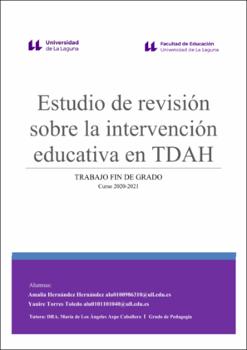Estudio de revisión sobre la intervención educativa en TDAH.
Fecha
2021Resumen
El TDAH o Trastorno por Déficit de Atención con/sin Hiperactividad es un trastorno
neurobiológico de carácter crónico que se caracteriza por la dificultad de mantener la atención
voluntaria y por la falta de control de impulsos. Habitualmente su diagnóstico se realiza en
edades tempranas, destacando sus síntomas hasta la adultez muchas veces.
El objetivo de este trabajo es, seleccionar, describir y analizar información básica y
relevante sobre el tema de la intervención educativa en TDAH; y por último sugerir una
propuesta para la intervención, en torno a lo que se puede aportar desde la pedagogía.
En cuanto a la selección de documentos para este estudio, se han encontrado 38
publicaciones de los cuales hemos seleccionado 8 para este estudio. Para realizar el análisis de
los documentos se han utilizado unas categorías de análisis que permiten conocer los aspectos
básicos de las intervenciones analizadas. Por último, se ha elaborado una discusión crítica sobre
la documentación bibliográfica recopilada y analizada, en la que se han obtenido algunos
avances para la intervención educativa en TDAH, teniendo aún mucho camino por correr para
llegar a la meta de inclusión tanto de forma externa (mayor responsabilidad y compromiso
social), como de forma interna (escuela). ADHD or Attention Deficit Disorder with/without Hyperactivity is a chronic
neurobiological disorder that is characterized by the difficulty of maintaining voluntary
attention and by the lack of impulse control. Usually their diagnosis is made at an early age,
highlighting their symptoms until adulthood many times.
The objective of this work is to select, describe and analyze basic and relevant
information on the subject of educational intervention in ADHD; and finally to suggest a
Estudio de Revisión sobre la Intervención Educativa en TDAH.
Amalia Hernández y Yanire Torres 2
proposed intervention, according to experience, around what the role or functions of a
pedagogue/teacher can contribute to ADHD students.
Regarding the selection of documents for this study, we have found 38 publications of
which we have selected 8 for this study. For the analysis of the documents, categories of
analysis have been used that allow to know the basic aspects of the interventions analyzed.
Finally, a critical discussion on the bibliographic documentation compiled and analyzed has
been developed, in which some advances have been made for the educational intervention in
ADHD, having a long way to go to reach the goal of inclusion both externally (greater social
responsibility and commitment), and internally (school).





